

|
|
 |
 |
 |
 |
// Источник: B.A.F. Newsletter,
Сентябрь 2004, No 48
Hanmi-handachi
SHIHO-NAGE
Katate-dori - number 2
Demonstrated and explained by Kanetsuka Sensei
|
|

Photos and text: Peter Megann
Graphics and typesetting: Graham and Laura Jones
Uke: Richard Martin
|
In the following sets of photographs, set 'a' shows the shiho-nage technique, set 'b' illustrates the relationship of the technique to sword-movement, and set 'c' concentrates on the basic body and hand movements.
Photo 1a: This represents the most difficult situation for Tori when the attacker has every advantage. The challenge is how to overcome Uke without using force. As Uke grasps Tori's left wrist with his right hand with a view to controlling Tori and pulling him forwards, he moves off the attacking line. As he holds Tori, his posture is similar to the forward movement of deep tori-fune, while he initiates an attack with his left hand. |
|
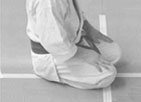 |
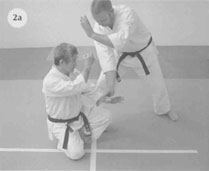 |
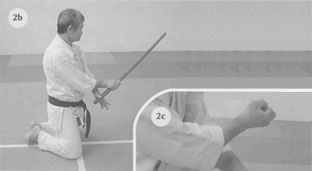 |
|
Photo 2a: Coming up onto his toes, Tori slides his left foot forward and raises his left knee. At the same time he makes atemi with his right hand and extends his left arm, bringing his left hand - coming into a more horizontal plane with fingers spread and thumb turning inwards - to the height of his solar plexus. His left elbow is turning outwards with a feeling of slashing Uke's right lower leg. Note that Tori's right hand remains in front of his centre (his back foot, navel, left toes and left hand remain on the same line). As Tori conies up onto his toes his centre rises and moves forwards. Note that the action of Tori's left arm resembles that at the beginning of the suwari-waza kokyu-ho exercise, his fingers open with the thumb turning downwards and his elbow expanding.
Photo 2b: In the parallel movement with the sword, Tori rises into kiza and raises the sword slightly. Note the light grip of the left hand, the fingers open, and contact with the sword maintained simply with the base of the thumb. The sword pivots around the right wrist as the left hand extends forward.
|
|
 |
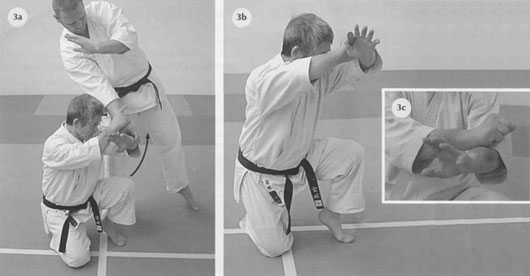 Photo 3a: As Tori lifts his hands above his forehead with his two wrists crossing, he takes a small step forwards and starts to turn to his right, at right angles to the attacking line. He lifts his left heel and pivots on the toes of his left foot and on his right knee. The grip of Tori's right hand on Uke's hand is similar to that of applying sankyo, while the action of his left hand is similar to a hand receiving sankyo. Uke is now brought up onto his toes and his body is turning away from Tori, as Tori effects a kind of winding movement. Tori's weight is now on his right knee and heel.
The sword movement shown in Photos 3b — 5b is known as maki-uchi (卷打) or 'winding-strike'. The sword is not brought up vertically in front of the head as in the normal shomen-uchi, but stays in the same place as Tori turns; so that that his left elbow comes to the sword before he raises it above his head. (In Photo 3b the sword is hidden behind Tori's left arm.)
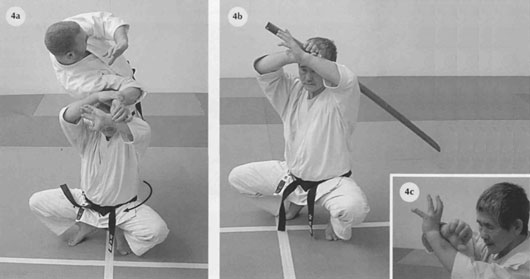 Photo 4a: Here is the mid-point of Tori's turning from front to back. As he reaches a point at right angles to the attacking line, he lifts his right knee and comes up onto the toes of both feet, pivoting under Uke's right hand. Note that he is not moving Uke's right hand at this point, simply pivoting underneath it. The flow of Tori's concentration proceeds from his toes through his centre to his elbow. Here we note the essential difference between the 'solid' form of the technique explained in Newsletter no. 47 in which Uke is brought round Tori, and this more 'flowing' form in which Tori moves round the contact point with Uke.
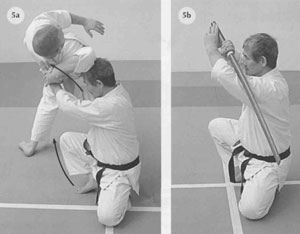 |
|
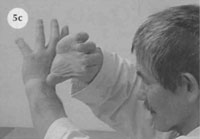
Photo 5a: Tori reverses the posture shown in Photo 3a by bringing his left knee to the tatami and raising his right knee. He brings Uke's right hand close to Uke's right shoulder blade. The fingers of Tori's left hand are pointing towards Uke's neck. If you execute this movement correctly there is no need to throw your partner. Uke should simply fall to the ground.
|
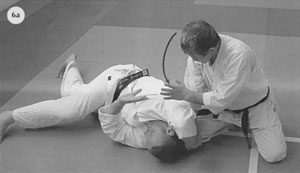 Photo 6a: As Uke falls, Tori sticks to him. He can finish either in kiza - pushing his tanden forward and his two knees and his toes forming a tripod - or he can finish in sonkyo, with his left knee on the tatami and his right knee raised (as shown in Photos 6a and 6b). His grip on Uke's right wrist with his right hand is similar to that of kosa-dori yonkyo.
Photo 6a: As Uke falls, Tori sticks to him. He can finish either in kiza - pushing his tanden forward and his two knees and his toes forming a tripod - or he can finish in sonkyo, with his left knee on the tatami and his right knee raised (as shown in Photos 6a and 6b). His grip on Uke's right wrist with his right hand is similar to that of kosa-dori yonkyo.
It is important that you master the 'solid' form of this technique first, otherwise you will not be able to execute the more 'flowing' form effectively. The 'solid' form is a simpler, circular movement with the advantage of developing stability and kokyu. The 'flowing' form is more advanced, requiring more tai-sabaki and flexibuity. |
 |
| |
|
 |
  |
 |



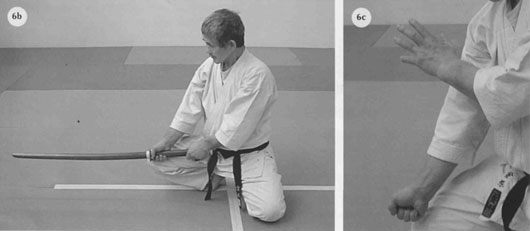
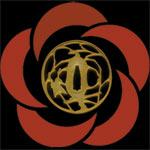
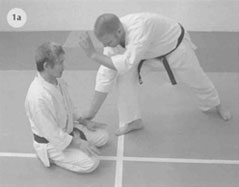
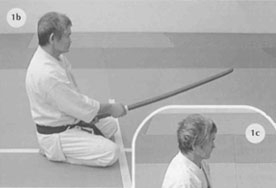






 Photo 6a: As
Photo 6a: As